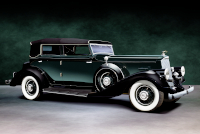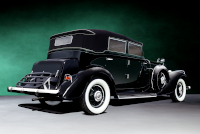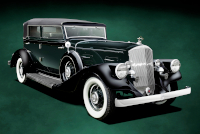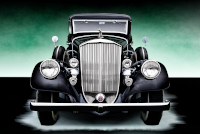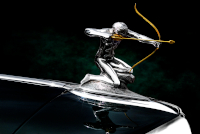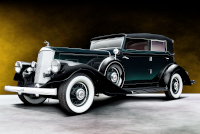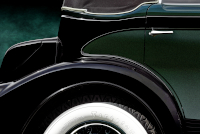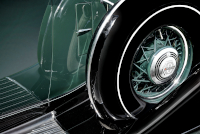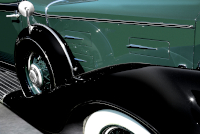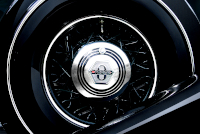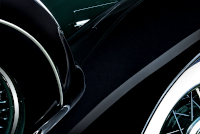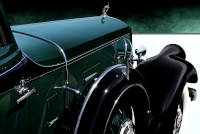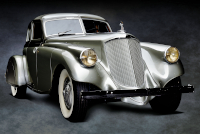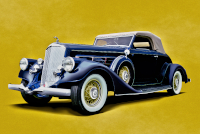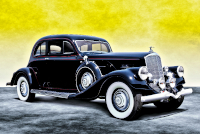Location:
St. Michaels Concours d'Elegance, 2016
Radnor Hunt Concours d'Elegance, 2016
St. Michaels Concours d'Elegance, 2015
Owner: Charles Berkeley Coons Gillet, Jr. (late) | Lutherville, Maryland
Prologue:
Mr. Gillet owned the car until his passing, after which RM Sotheby's sold #2080338 at Hershey in 2021. Today, the 840A resides in the 3 Dog Garage collection of Ross and Beth Myers of Boyertown, Pennsylvania.
For a few years, this restored and refurbished Pierce-Arrow appeared at shows from coast to coast, Pebble Beach included, of course. Chassis #2080338 is an unlikely hero for being a straight-8 Pierce-Arrow, whereas its convertible sedan configuration and stellar presentation stand out. The open car concept is similar to the grand phaetons of the era, though of a particular class where the fit and finish is much more refined than a touring car. We see a similar composition in the Duesenberg Riviera Phaeton by Brunn, where the concept is a special take on the grand touring car built on a short chassis, which keeps the proportions absolutely proper.
And for local flavor, as a native Baltimorean, I am always interested in those regional cars that draw national regard. Learning a little more about Mr. Gillet in the course of putting this profile together has been worthwhile, a case where both the car and its steward deserve the utmost respect.
- - - - - - - - - -
► Image Source 1-5, 7-13, 16-18: Nikon D750 (24.3 MP), St Michaels 2015-2016 and Radnor Hunt 2016
Image Source 6, 14-15: Nikon D200 (10.2 MP) by E, St Michaels 2015, edited by the author
References:
- Ralston, Marc. "Pierce-Arrow" A.S. Barnes & Co., Inc., San Diego, CA. 1980, page 179-180, 232
- Automobile Quarterly, Volume 28, Number 4, Fourth Quarter 1990, "The Last Years of Luxury" by John C. Meyer III, The Kutztown Publishing Company, Inc., Kutztown, PA, page 97
- RM Sotheby's: The listing for #2080338, sold at the 2021 Hershey auction.
- 3 Dog Garage: The current home of chassis #2080338 in Boyertown, Pennsylvania.
- VeloceToday: "Road & Track, the Bond Years" by Pete Vack, April 12, 2021
- Legacy: Mr. Gillet's obituary from 2021.
- Auto Color Library: The Pierce-Arrow color schedule from 1933 to 1936.
The convertible sedan depicted here is a rare and regal statement of the marque's legacy, though as much noteworthy for its 8-cylinder motor as for its unique coachwork. There is only one car of this configuration, most often seen with its hood up to retain good proportions, and the car appears to use the shorter 139-inch wheelbase. So the car is smaller and less powerful than it could be, but the LeBaron coachwork is nonetheless one of the more elegant designs seen on a Pierce-Arrow of this vintage—a bit of an unsung hero in this respect.
Restored by Charles Gillet from 2013 to 2015, the car quickly circulated the concours scene and delivered show-topping results normally reserved for Art Deco machinery and American cars of the multi-cylinder numbers race. The convertible sedan is properly elegant, a lovely representation of the marque's slimmed and trimmed lines for 1934. As a Baltimore native whose formative stomping grounds included northern haunts around Lutherville, I always smiled to see this car, among others brought to shows by Mr. Gillet.
Charles Gillet and His Classic Cars
After graduating from Yale, Mr. Gillet became a member of the Navy Underwater Demolition Team, (the UDT, known as the original frogmen, precursor to the Navy SEALs), and served in the Pacific theater during World War II. Gillet subsequently volunteered as an active reservist in the Korean Conflict. By the end of his Navy career, he compiled 18 years of service.
For Gillet, automobiles were more than just an avocation, as one of his first jobs after retiring from the Navy was automotive journalist for the Baltimore News-American, which eventually led to a role as an editor of Road & Track magazine. A VeloceToday article with support from John Bond, Jr., son of owner John Bond who acquired the title in 1952, tells us that "Charles Gillet had a significant impact on the fortunes of the magazine. While David E. Davis attributed the New Yorker style to Elaine Bond, the originator may have been Gillet, who became associate editor in 1954, and got the job by showing up at the office with a copy of Road and Track having blue lined the typos and errors he had spotted. He also suggested making the magazine '…the New Yorker of the automotive press.' (R&T June 1997). The Bonds fully agreed and made Gillet a new associate editor, just under Bond himself as editor. John Bond Jr. recalls that as a young boy he knew him as an uncle figure, and that under Gillet the magazine really prospered, helping pay off [a] costly promissory note."
So in many ways, Mr. Gillet did the business, both as a serviceman to his country and as a creative in the automotive press. His personal history underscores the respect associated with his name when, say, he brought his Pierce-Arrow to a show. And as a fellow Baltimorean I merely hope to pass along those better points.
The Hurt of Pierce-Arrow's 1934 Bankruptcy
Although Pierce-Arrow would survive until 1938, the bells sounded in 1934, when the company applied for bankruptcy under new reorganization laws. Pierce-Arrow completed the reorganization in March of 1935. President A.J. Chanter secured a million dollars in new funds on the condition of reoganization, but the deal proved to be a double-edged sword. While able to remain in business, the reorganization forced the disposition of the Pierce-Arrow Sales Corporation, its vaunted dealer network that dated back to the days of nationwide Pierce bicycle distribution. Furthermore, the federal court limited production to control costs during receivership, but below the number of actual orders. So Pierce-Arrow lost its means to meet demand and sell its product.
To underscore the physical state of the firm during bankrupcty, Automobile Quarterly quotes a Buffalo newspaper at the time: "Principal branches of the Pierce-Arrow Motor Car Company, whose cost has been too heavy for the company to bear without the contemplated reorganization, were sales offices and a service station in Manhattan and a service station in Brooklyn." If these were the principal locations of the day, then the massive corporate atrophy could explain how record-keeping became scant toward the end of operations.
Not that the most benevolent of support would resurrect a luxury automaker in the Depression era. Outside of the big three corporations, only Packard would contribute to post-War production in any meaningful capacity.
Motor: 6,309 cc (385 cubic inches) inline 8-cylinder, cast-iron block, | 88.9 mm x 127 mm (3½" x 5") | motor #305467
The 1934 840A received a slightly larger motor than the 366 cubic inch 836 of 1933 (and subsequent 836A of 1934), and hence, delivered a marginal 5 horsepower increase.
Valvetrain: L-head, 2 valves per cylinder
Power: 140 hp @ 3,400 rpm
Drivetrain: 3-speed synchromesh gearbox, rear-wheel drive
Architecture: steel ladder frame chassis with steel body over wood frame
Wheelbase: 3,530.6 mm (139 inches)
Top Speed: Approximately 112 km/h (70 mph)
Etymology:
The Model 840A emerged in 1934 using the somewhat sensible nomenclature begun the previous year. 1933 saw the debut of the 836, an 8-cylinder car on a 136-inch wheelbase chassis. That car became the 836A in 1934. A step above, the 840A appears without direct precedent, built on either a 139-inch or 144-inch chassis. These dimensions are the same as the upper-level Model B (139-inch) and Model A (144-inch) cars of 1930, with some gap before the 139-inch chassis emerged again in 1933, where it could be ordered for the 836 or 1236. (Complicating matters, Ralston notes that the 139-inch wheelbase 8-cylinder car is, in fact, a Model 839, but that the company classified it as a Model 836 anyway.) But by 1934, the 836A is strictly a 136-inch chassis car, whereas the 840A provides options.
Figures:
Records do not account for models among total annual production in these years, which equal 1,740 cars in 1934. However, this Convertible Sedan by LeBaron is rare, appearing on some very small number of chassis dating back to 1932.
Value:
Chassis #2080338 sold at RM Sotheby's 2021 Hershey auction for $330,000.
1934 Updates: Styling Common to 1934 Pierce-Arrow Cars
The LeBaron Convertible Sedan uses an earlier straight guard, as opposed to the updated chinstrap version common to most 1934 models, a multi-piece unit with a central curve to mimic the vee at the base of the grille. The balance of updates jive with most 1934 cars. The grille itself is chrome, and the shroud painted to match the body. The archer mascot now fixes directly to the shroud on a scalloped pedestal, as opposed to the more prominent radiator cap of 1933. Bonnet side vents comprise three rectangular doors with chrome darts. Ralston incorrectly notes that the bonnet uses two such doors, but seems to have been referring to the two upper vents that Pierce-Arrow replaced with a long panel of three vents the following year, eliminating the lower vent that hides here behind the spare. At the tail, the 1934 cars use the integrated light fixture first seen on the Silver Arrow show car.
The 1934 Pierce-Arrow uses lithe, flowing running gear, fenders that trickle over the wheels and flow down the flanks. These are not grand gestures but nicely proportioned accents to the curves necessitated by the wheel arches. The high and light heart-shaped cut of the front valance matches the nimble tail fenders, and the skirts both front and rear are slender. 1935 will ground the skirts with a nearly flat chrome line, and draw deeper cuts around the arches. So within the 1934 model year we see a light touch, very much reminiscent of the 1933 Packard. These are among the prettiest of the classic era, just at the advent of skirted fenders. Both Packard and Pierce-Arrow running gear will grow progressively heavier in subsequent years.
Thessalon Green: A Word on Period Pierce-Arrow Color
Various Pierce-Arrow owners note that Pierce-Arrow used Thessalon Green as an all-over color on the body, boards, and wheels. However, coachwork from LeBaron might explain the black contrast, if in fact original. Regardless, the contrast completes the look. I imagine that anyone who has read an article about this car likes to silently whisper the word, 'Thessalon,' thinking of some mythical flying steed, whereas Thessalon is a rather small town in Canada. Across the Great Lakes at the northwest corner of Huron, the town may have been of some significance to someone in Buffalo.
Tireur d'Arc: Minor Updates to the Archer Mascot
The 1934 model year sees a revision to the archer, who now kneels on a narrow, scalloped pedestal. This change reduces the mascot's prominence, (no longer sitting atop a round radiator cap like a trophy), and nicely incorporates the arrow theme with a pointed base. The previous mascot and shroud look much more the silver tea service, less a design consideration than an assembly of riches, (though both forms are nice in their own right). The contrast of plated metal and painted shroud is also a welcome change, particularly with a rich body color. Here, the bronze arrow and deep green hue pair well.
Belt and Binding: Distinguishing LeBaron Design among Pierce-Arrow Elements
The LeBaron Convertible Sedan uses body moulding similar to the phaeton of 1932, with a broader sweep at the rear hips that is easy to recognize as a whole curve, and not so deep and pointed as its predecessor on the Model B, for instance. The car also uses a tapered the rear deck and incorporates a handsome boot above the luggage rack, as seen on some grand Pierce-Arrow touring cars of this early classic era vintage. With this livery, the effect seems to predict a few of the special-body cars yet to come, for example, the Model 1602 Club Sedan of 1935, and the V-12 town cars produced by Brunn and Derham in 1936. Though a straight-8, this LeBaron Convertible Sedan is of the same class.
With so much owed to marque updates, LeBaron influence really lives above the belt. The car looks at a glance to be a closed sedan, but subtle ribs in the hood, a stitched collapsible crown, and a glimpse of the internal irons through the cabin reveal the open-air plan. And that is not-so standard. Also note how LeBaron opposed the doors, with suicide doors at front and conventional doors at rear, both of which appear to share a single central hinge mechanism. These are clever components that seem the province of a custom coachbuilder. How do we remove the top? How do we elevate the simplicity of ingress and egress? How do we refine the hardware? LeBaron took a standard platform, albeit rather pleasing, and pulled a few tricks to create something special.
Last Updated: Mar 26, 2025

